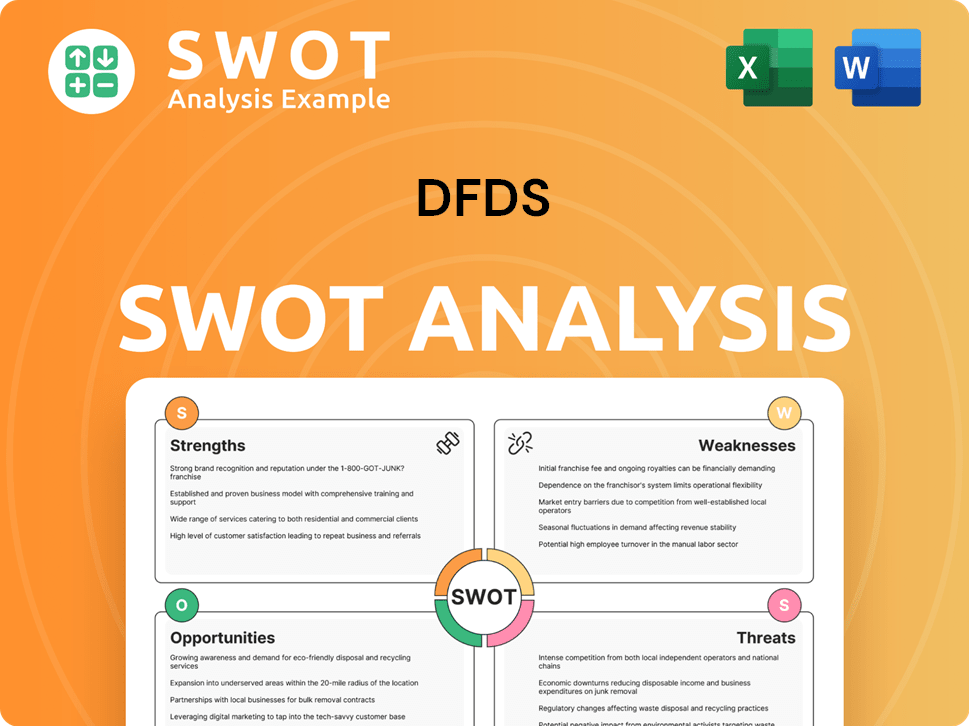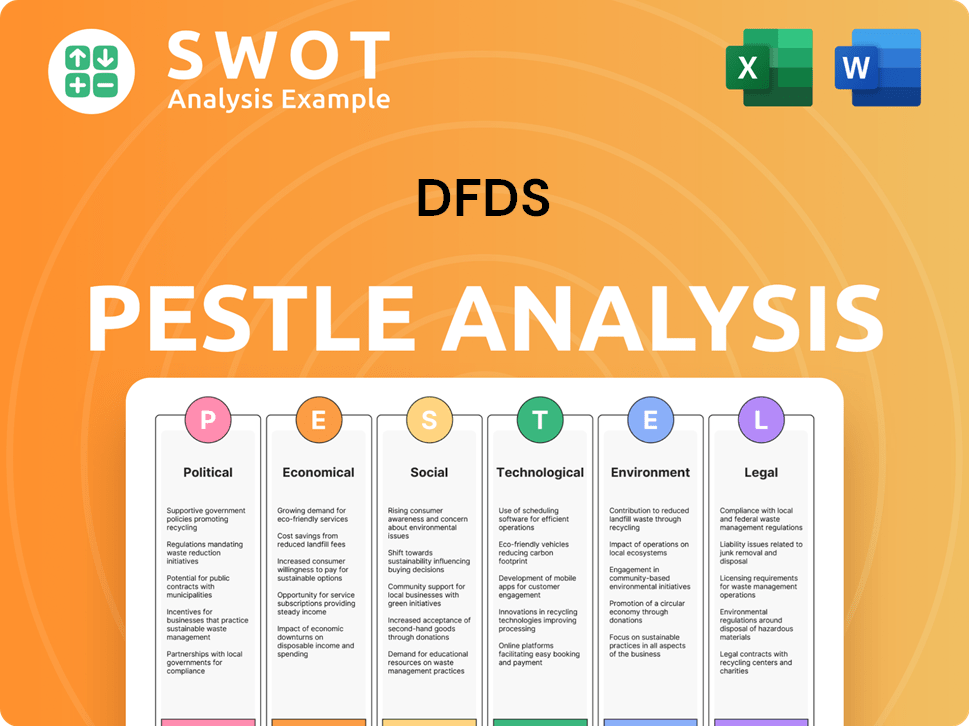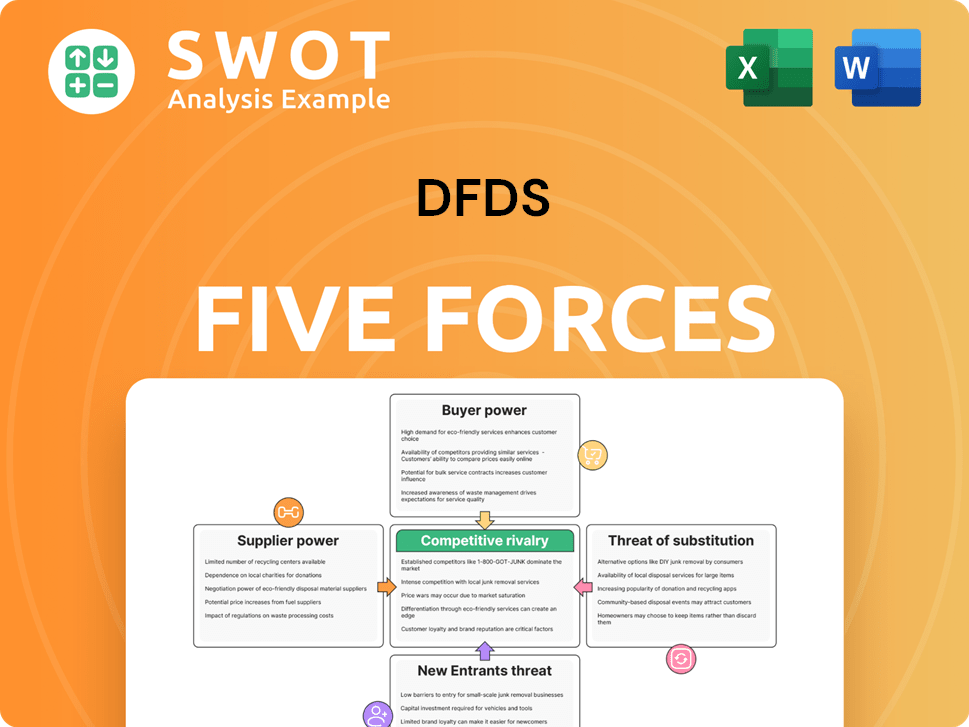DFDS Bundle
How Does DFDS Navigate the Choppy Waters of the Shipping Industry?
DFDS, a titan in European shipping and logistics, faces a complex web of rivals and market pressures. Its strategic moves, including green shipping investments and network expansions, are crucial for maintaining its position. Founded in 1866, DFDS has evolved from a regional player to a global enterprise. This analysis dives deep into the DFDS SWOT Analysis, competitive landscape, and how it competes in a rapidly changing sector.

This exploration of the DFDS competitive landscape will provide a thorough DFDS market analysis, examining its primary DFDS competitors and the strategies that define its success. We'll dissect the DFDS industry dynamics, including freight transport, market share analysis, and the competitive advantages DFDS leverages. Understanding DFDS's positioning requires a detailed look at its service offerings, route network, and how it utilizes technology to gain an edge in the shipping industry analysis.
Where Does DFDS’ Stand in the Current Market?
DFDS holds a significant market position within the European shipping and logistics industry. The company is a key player in Ro-Ro (Roll-on/Roll-off) freight and passenger ferry services. DFDS operates across major routes, including the English Channel and those connecting Scandinavia with Continental Europe, making it a central figure in the DFDS competitive landscape.
The company's primary offerings include ferry services for freight and passengers, port terminal operations, and integrated logistics solutions. DFDS serves a diverse customer base, from large industrial clients to individual tourists. In 2023, DFDS reported a revenue of DKK 27.2 billion, highlighting its substantial scale within the industry. This financial performance underscores DFDS's strong position in the shipping industry analysis.
DFDS has strategically evolved, emphasizing integrated logistics to offer end-to-end supply chain services. This diversification allows the company to provide comprehensive solutions beyond just port-to-port transportation. DFDS's commitment to digital transformation further enhances operational efficiency and customer experience. To understand the company's approach to identifying its ideal customers, you can read about the Target Market of DFDS.
DFDS's core operations revolve around Ro-Ro freight and passenger ferry services. These services are crucial for transporting goods and people across key European routes. The company also operates port terminals and provides integrated logistics solutions, including road, rail, and warehousing.
DFDS offers a comprehensive value proposition by providing reliable and efficient transportation solutions. They focus on integrated logistics, offering end-to-end supply chain services. Their strong route network and commitment to customer service further enhance their value.
DFDS has a strong presence across Northern Europe, including the UK, Ireland, Scandinavia, and the Baltic States. Their extensive network and strategic positioning make them a key player in the region. This broad geographical reach supports their ability to compete effectively in the DFDS industry.
In 2023, DFDS reported an EBITDA of DKK 4.7 billion, demonstrating robust operational profitability. This financial health allows the company to invest in growth and maintain its competitive edge. The strong financial performance is a key factor in the DFDS market analysis.
DFDS faces competition from various players in the shipping and logistics sectors. Key factors influencing the market include route efficiency, service integration, and sustainability initiatives. Understanding these dynamics is crucial for analyzing DFDS competitors.
- Route Network: DFDS's extensive route network provides a significant advantage.
- Service Integration: Offering integrated logistics solutions enhances competitiveness.
- Digital Transformation: Investments in technology improve operational efficiency.
- Sustainability: Initiatives to reduce environmental impact can create a competitive edge.
DFDS SWOT Analysis
- Complete SWOT Breakdown
- Fully Customizable
- Editable in Excel & Word
- Professional Formatting
- Investor-Ready Format

Who Are the Main Competitors Challenging DFDS?
The DFDS competitive landscape is shaped by a diverse array of rivals across its ferry and logistics operations. Understanding these competitors is crucial for a comprehensive DFDS market analysis and assessing its strategic positioning. The company faces both direct and indirect competition, requiring it to constantly adapt and innovate to maintain its market share and profitability.
DFDS competitors employ various strategies to challenge its market position. These include aggressive pricing, investments in newer vessels, enhanced onboard services, and technological advancements. The intensity of competition varies by route and service, with high-volume routes often witnessing the most significant battles for market share. The company's success depends on its ability to differentiate itself through superior service, efficient operations, and strategic partnerships.
Direct competitors in the ferry market include Stena Line, Brittany Ferries, and P&O Ferries. These rivals compete on various routes, offering passenger and freight services.
Stena Line is a major ferry operator globally, directly competing with DFDS on routes in the North Sea and Baltic Sea. They focus on efficiency and sustainability.
Brittany Ferries primarily challenges DFDS on routes connecting the UK with France and Spain, targeting both passenger and freight segments.
P&O Ferries competes intensely with DFDS, particularly on the English Channel, focusing on both freight and passenger volumes. Price competition is common.
In the broader logistics sector, DFDS competes with road hauliers, rail operators, and third-party logistics providers like DB Schenker and DSV.
Emerging players in digital freight forwarding and last-mile delivery are disrupting the market with technology-driven solutions. Consolidation in the industry intensifies competition.
DFDS and its competitors employ various strategies to gain market share and improve profitability. These strategies include:
- Pricing Strategies: Competitive pricing is a common tactic, especially on high-volume routes.
- Fleet Investments: Investing in newer, larger, and more efficient vessels is crucial.
- Service Enhancements: Improving onboard services and amenities to attract passengers.
- Technological Advancements: Utilizing technology for booking, logistics management, and operational efficiency.
- Strategic Partnerships: Forming alliances to expand service offerings and market reach. The Growth Strategy of DFDS highlights some of these partnerships.
DFDS PESTLE Analysis
- Covers All 6 PESTLE Categories
- No Research Needed – Save Hours of Work
- Built by Experts, Trusted by Consultants
- Instant Download, Ready to Use
- 100% Editable, Fully Customizable

What Gives DFDS a Competitive Edge Over Its Rivals?
Analyzing the Owners & Shareholders of DFDS reveals insights into its robust competitive advantages. DFDS has strategically built a strong presence in the shipping industry, focusing on ferry routes and integrated logistics solutions. This approach has positioned it favorably within the DFDS competitive landscape. The company's ability to adapt and innovate has been crucial in maintaining its edge in a dynamic market.
DFDS's strategic moves, including significant investments in its network and logistics capabilities, have enhanced its competitive edge. These investments have allowed DFDS to offer comprehensive services, from ferry transport to warehousing, attracting a diverse customer base. The company's commitment to digital transformation further boosts its operational efficiency and customer satisfaction, solidifying its market position.
The company's financial performance, compared to rivals, reflects the success of its strategies. DFDS has demonstrated consistent growth and profitability, supported by its efficient operations and strong customer relationships. This financial stability enables DFDS to continue investing in its infrastructure and services, further strengthening its competitive advantage in the freight transport sector.
DFDS boasts an extensive network of ferry routes, a significant barrier to entry for new competitors. This established network provides unparalleled connectivity and frequency for both freight and passenger traffic across Northern Europe. The breadth of its routes allows DFDS to serve a wide range of customers efficiently.
Operating a large fleet of vessels and managing numerous port terminals, DFDS benefits from economies of scale. This scale allows for cost efficiencies in fuel consumption, maintenance, and crew management. These efficiencies contribute to competitive pricing and sustained profitability.
DFDS has integrated its ferry services with comprehensive logistics solutions, offering a 'door-to-door' service. This includes road, rail, and warehousing services alongside sea transport, providing a seamless supply chain solution for businesses. This integrated approach enhances customer loyalty and market share.
DFDS focuses on digital transformation, including online booking platforms and real-time tracking for freight. These technologies improve operational efficiency and customer experience. Digital initiatives enhance the company's ability to adapt to market changes and customer demands.
DFDS's competitive advantages include its extensive route network, economies of scale, integrated logistics solutions, and digital transformation efforts. These elements combine to provide a strong market position. DFDS leverages these strengths to maintain its leadership in the shipping industry.
- Extensive Route Network: Provides unparalleled connectivity and frequency.
- Economies of Scale: Enables cost efficiencies in operations.
- Integrated Logistics: Offers seamless supply chain solutions.
- Digital Transformation: Improves operational efficiency and customer experience.
DFDS Business Model Canvas
- Complete 9-Block Business Model Canvas
- Effortlessly Communicate Your Business Strategy
- Investor-Ready BMC Format
- 100% Editable and Customizable
- Clear and Structured Layout

What Industry Trends Are Reshaping DFDS’s Competitive Landscape?
The European shipping and logistics sector, where the company operates, is undergoing significant shifts. These include a strong push towards decarbonization, the integration of digital technologies, and a focus on making supply chains more resilient. Understanding the DFDS competitive landscape requires an understanding of these dynamics, as they shape both the challenges and opportunities for the company.
The primary risks stem from geopolitical instability, fluctuating fuel costs, and potential labor shortages. However, the company is also presented with opportunities in emerging markets and through the expansion of logistics services. The company's ability to adapt to these changes will be crucial for its long-term success in the DFDS industry.
The shipping industry is seeing a strong emphasis on sustainability, which includes reducing carbon emissions. Digitalization is also a key trend, with companies using technology to improve efficiency and customer service. Supply chain resilience is becoming more important due to global uncertainties, influencing how companies operate and invest.
Geopolitical issues and fluctuating fuel prices pose significant risks to the industry. Labor shortages and increased regulatory scrutiny regarding emissions and working conditions are also challenges. The company must navigate these issues to maintain its competitive position and operational efficiency.
Growth opportunities exist in emerging markets, especially in Eastern Europe, and through expanding logistics services. The complexity of global supply chains creates demand for integrated solutions. Strategic partnerships and technological advancements could unlock new efficiencies and market access.
The company is evolving into a more integrated, sustainable, and technologically advanced service provider. It leverages its strong network and brand to stay resilient. This evolution is critical for maintaining its competitive edge. The company's investments in sustainable practices and digital technologies are central to its strategy.
The company’s future hinges on its ability to navigate these trends and challenges. It involves strategic investments, operational efficiencies, and adapting to market changes. The company's approach to sustainability and technology will be key differentiators in the DFDS market analysis.
- Sustainability Initiatives: Investing in new, fuel-efficient vessels and exploring alternative fuels.
- Digital Transformation: Continuing to invest in digital platforms, automation, and data analytics.
- Strategic Partnerships: Collaborating with technology providers and other logistics firms.
- Market Expansion: Focusing on growth in emerging markets and diversifying logistics services.
DFDS Porter's Five Forces Analysis
- Covers All 5 Competitive Forces in Detail
- Structured for Consultants, Students, and Founders
- 100% Editable in Microsoft Word & Excel
- Instant Digital Download – Use Immediately
- Compatible with Mac & PC – Fully Unlocked

Related Blogs
- What are Mission Vision & Core Values of DFDS Company?
- What is Growth Strategy and Future Prospects of DFDS Company?
- How Does DFDS Company Work?
- What is Sales and Marketing Strategy of DFDS Company?
- What is Brief History of DFDS Company?
- Who Owns DFDS Company?
- What is Customer Demographics and Target Market of DFDS Company?
Disclaimer
All information, articles, and product details provided on this website are for general informational and educational purposes only. We do not claim any ownership over, nor do we intend to infringe upon, any trademarks, copyrights, logos, brand names, or other intellectual property mentioned or depicted on this site. Such intellectual property remains the property of its respective owners, and any references here are made solely for identification or informational purposes, without implying any affiliation, endorsement, or partnership.
We make no representations or warranties, express or implied, regarding the accuracy, completeness, or suitability of any content or products presented. Nothing on this website should be construed as legal, tax, investment, financial, medical, or other professional advice. In addition, no part of this site—including articles or product references—constitutes a solicitation, recommendation, endorsement, advertisement, or offer to buy or sell any securities, franchises, or other financial instruments, particularly in jurisdictions where such activity would be unlawful.
All content is of a general nature and may not address the specific circumstances of any individual or entity. It is not a substitute for professional advice or services. Any actions you take based on the information provided here are strictly at your own risk. You accept full responsibility for any decisions or outcomes arising from your use of this website and agree to release us from any liability in connection with your use of, or reliance upon, the content or products found herein.